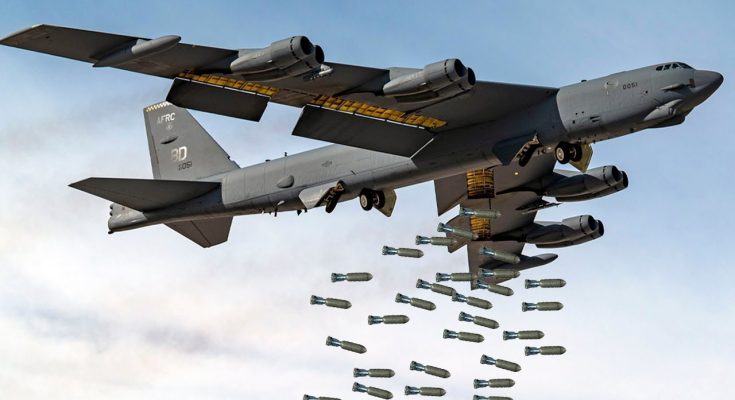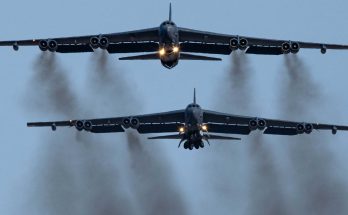The Boeing B-52 Stratofortress is one of the most iconic and enduring strategic bombers in the history of military aviation. Originally introduced in 1955 by the United States Air Force, this long-range, subsonic jet aircraft has been continuously updated and modified to meet the demands of modern warfare, ensuring its relevance even after more than 70 years of service. Known for its versatility, impressive payload capacity, and long endurance, the B-52 remains an essential asset for the U.S. military, ready to respond to high-alert situations and serve as a cornerstone of America’s airpower and global deterrence strategy.
A Legend of Longevity and Capability
The B-52 was designed during the Cold War to carry out long-range, nuclear deterrence missions. With its distinctive swept-wing design and eight turbojet engines, the B-52 has the capability to carry up to 70,000 pounds (31,750 kg) of bombs or precision-guided munitions. This extraordinary payload capacity, combined with its range of over 8,800 miles (14,080 km), allows the B-52 to perform a wide variety of strategic missions, including conventional bombing, reconnaissance, and precision strikes on high-value targets.
While initially designed for nuclear bomb delivery, the B-52’s role has evolved with technology and geopolitical needs. Today, the aircraft is not only capable of carrying nuclear payloads but also is equipped with precision-guided munitions and long-range missiles, allowing it to perform conventional missions with deadly accuracy. It can deploy cruise missiles, smart bombs, and a range of advanced weaponry that give it unparalleled flexibility.
A Workhorse for High-Alert Missions
The B-52’s ability to maintain a high-alert posture makes it a key component of the U.S. Air Force’s strategic bomber force. The aircraft is kept on high-readiness status to respond swiftly to any crisis, providing a vital tool in scenarios where fast and powerful airpower is needed. Whether as a nuclear deterrent or in conventional strike scenarios, the B-52 is designed for rapid deployment and can be scrambled to any part of the world within hours. The aircraft’s impressive combat radius, long endurance, and ability to operate from bases across the globe enable it to project U.S. power anywhere, anytime.
With its ability to be quickly refueled in flight, the B-52 is capable of carrying out missions over extended distances without the need for frequent landings, allowing it to stay in the air for many hours or even days if required. This long endurance and flexibility have solidified its role as a strategic bomber capable of remaining operational in high-alert scenarios, ensuring that the U.S. has the ability to respond to threats anywhere on the globe.
Modernization Efforts and Future of the B-52
Despite being decades old, the B-52 continues to be a vital component of the U.S. military’s strategic arsenal due to a continuous series of upgrades. Modernization programs have seen the aircraft’s avionics, weapons systems, and communication capabilities brought up to the cutting edge, ensuring that the B-52 remains capable of operating in a rapidly evolving threat environment. These upgrades include improved radar systems, the integration of advanced GPS and targeting technology, and the incorporation of next-generation defensive systems to help protect the bomber from increasingly sophisticated air defenses.
Additionally, the B-52 is expected to remain in service until at least 2050, with further updates planned to keep it relevant for decades to come. Its ability to carry new, cutting-edge weapons, including hypersonic missiles, enhances its value, ensuring it remains a formidable tool for global deterrence and strike missions.
High-Alert Strategic Importance
The B-52 Stratofortress is not just an old bomber; it is a versatile, high-alert aircraft that continues to play a pivotal role in U.S. defense strategy. The aircraft’s ability to adapt to changing technologies and threats, coupled with its unmatched payload capacity and range, makes it a symbol of strength and resilience in modern airpower. Whether stationed in the U.S. or deployed to forward bases, the B-52 can be called upon to respond rapidly to high-alert situations, ensuring that the U.S. military is always ready to project power and maintain global stability.
In conclusion, the Boeing B-52 Stratofortress continues to be an indispensable part of U.S. strategic defense, capable of performing high-alert missions across vast distances. With its unparalleled versatility, impressive payload, and ongoing modernization, the B-52 remains a key pillar of American airpower, delivering deterrence, precision strikes, and long-range capabilities in the 21st century.



